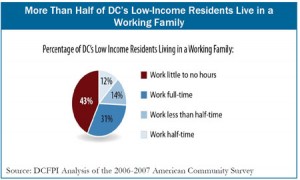Nearly one out of every four DC residents’133,000’lived in families with incomes below 150 percent of the poverty line even before the recession hit. This means a family of three was living on less than $25,000 a year. Now that the recession has hit, we know that things have gotten worse for many of those families who were already vulnerable to begin with. A new DCFPI report, Who Is Low-Income in DC?, helps shed light on how DC should target its resources to help families move toward economic security.
The report details which groups of DC residents are most likely to be low income and which groups of DC residents make up the largest shares of DC’s low-income population. The report also reveals that thousands of working families remain low-income because of low-wage jobs and finds that better jobs’including better wages’are critical to helping families move toward economic security.
The analysis finds that:
- A majority (57 percent) of low-income residents live in working families and nearly one-third live in full-time working families. Low wages earned by DC’s working poor — with a typical wage of just $9.14 an hour ‘ is one of the main causes of economic insecurity for low-income working families. At the same time, a significant share of low-income residents are in a family with little or no work experience in the past year.
- Helping low-income residents obtain stable jobs with modest wages can move a
 significant number of low-incomes residents above 150 percent of poverty. In fact, full-time work at $15 an hour would be enough to lift 80 percent of low-income residents above 150 percent of poverty. Setting target wages at this level isn’t an unrealistic goal. A number of jobs in DC pay these types of wages and require some specialized training, but not a four year degree, such as construction laborers and medical equipment repairers. DC can work to indentify suitable occupations and them provide training for them.
significant number of low-incomes residents above 150 percent of poverty. In fact, full-time work at $15 an hour would be enough to lift 80 percent of low-income residents above 150 percent of poverty. Setting target wages at this level isn’t an unrealistic goal. A number of jobs in DC pay these types of wages and require some specialized training, but not a four year degree, such as construction laborers and medical equipment repairers. DC can work to indentify suitable occupations and them provide training for them. - A significant number of people live in families where their ability to work may be limited. One-third of low-income residents live in families where the adults are elderly or have a disability, or both. Remedies to help these families achieve economic security need to take into account programs and policies that are geared towards those who cannot work, or where work may be difficult to find.
- Nearly half of low-income residents live in single-parent families. Single parents earn the lowest median wages of any family type and will need targeted assistance, such as child care, to help make them available for work, and help getting connected to quality training programs that can prepare them for jobs that can support a family on one salary.
The analysis presents broad policy conclusions and recommendations that the District should consider when designing programs and policies to help low-income families in DC achieve economic security. The full report, can be found here: https://www.dcfpi.org/wp-content/uploads/2010/10/10-26-10-Poverty-Demographic.pdf
